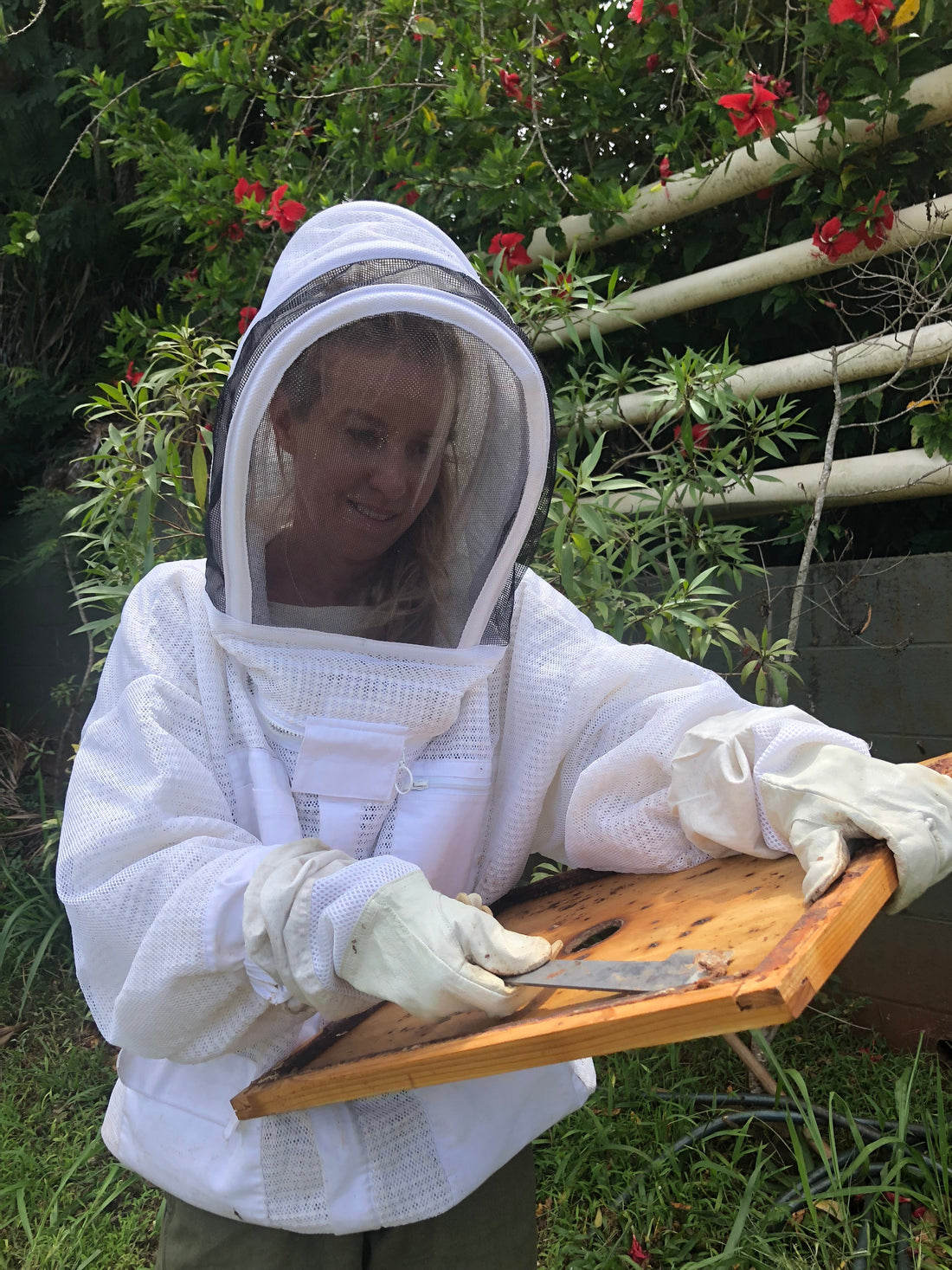
Ethical & Sustainable Skincare with Organic Honey & Beeswax
Share
Since our founding, Honey Girl Organics' core ethos has been built on a deep respect for nature and a strong commitment to sustainable, eco-friendly practices. Organic beeswax and honey are at the heart of our natural skincare products and harvested honoring the lives of the bees responsible for producing them. We are dedicated to a cruelty-free approach, ensuring our honey and beeswax are gathered without harming our valued pollinators.
Gentle Harvesting - a Sustainable Future
True beauty happens in harmony with nature. Our local certified-organic apiaries’ harvesting methods respect the hives' natural rhythms and prioritize the well-being of the glorious bees that thrive in an organic environment free from chemicals and other unnatural stressors.
Our ingredients are carefully extracted keeping all of their skin-healing properties intact and bioavailable, along with the additional naturally occurring pollen, propolis and royal jelly. This is all done while supporting the sustainability of the bee populations, their hives and the integrity of the environment.
Honey Girl Organics ONLY sources hive ingredients from organic apiaries whose priority is the well-being of the bees, unlike many large-scale and migratory commercial beekeeping practices that are disruptive to the hives and the bees' health. While all our hive ingredients our sourced from organic apiaries, we are happy to share that over 99% of our hive ingredients are sourced locally here in Hawaii. (1)(2)

Honey Extraction - a Gentle, Sustainable Process
Honey extraction begins after multiple careful hive inspections to ensure the bees are healthy and their environment is balanced. Our experienced beekeepers assess the colony’s needs, checking for signs of stress or disease, and determine what needs to be done to protect the hive, as well as the optimal time for the honey harvest. This proactive monitoring helps ensure that only surplus honey is taken, leaving the bees with more than enough to thrive.

Calming the Bees
A light puff of smoke near the hive entrance is used to calm the bees before harvesting. This triggers a temporary calming response without causing distress, allowing the beekeeper to work safely and keep the bees unharmed.
Fun Fact: Elaborate hieroglyphs from the 26th Dynasty (672 BC to 525 BC) of Ancient Egypt show how honey was harvested, including the use of vessels with scented offerings, gently burnt to produce incense, a form of smoking bees. This practice likely served to calm the bees before opening the hives, like how modern beekeepers use smokers. (3)

Frame Removal and Extraction
The honey is stored in hexagonal-shaped honeycombs on the frames made of beeswax, which are carefully removed from the hive. We use hand-operated tools to detach the frames with minimal disruption to the bees, and place them into a centrifugal extractor. This gently spins the frames, causing the honey to flow out without the application of heat or chemicals which would compromise the integrity of the naturally occurring enzymes, pollen, propolis and royal jelly present.

Minimal Filtration
After extraction, the honey is strained to remove any large particles or wax remnants while preserving the valuable nutritional properties that contribute to its valued health benefits. This careful filtration ensures that the raw, organic character of the honey is maintained.
Beeswax Extraction - Respecting Nature’s Blueprint
Harvesting the Wax
Beeswax is an essential material for the bees’ hive construction, and naturally replenished as bees rebuild their comb. After the honey has been extracted, the excess wax combs are carefully collected and the bees rebuild as they collect more nectar to deposit into the hive.
Cleaning and Melting
The harvested wax is then gently warmed at low temperatures, allowing for the separation of impurities, filtered through fine meshes strainers.
This process retains all of its natural healing and protective properties.

Filtering and Setting
The resulting pure beeswax is then allowed to cool and solidify in blocks that we use in our skincare products. This method of wax extraction is environmentally friendly and sustainable.
Balancing the Harvest with the Bees' Needs
Our honey and beeswax extraction processes are designed with respect for our pollinators. We assure you that:
- Surplus Harvesting: Only excess honey is taken, guaranteeing that the bees always have enough to nourish their colony.
- Non-Intrusive Methods: The extraction methods are performed with minimal disturbance to the hive, ensuring that the bees remain calm and stress-free throughout the process.
-
Sustainable Practices: By using gentle extraction techniques and giving the bees time to naturally replenish their wax, we maintain a balance that supports both the bees and the ecosystem.

Organic Production![]() - from Hive to Skincare
- from Hive to Skincare
The organic journey of our beehive ingredients reflects our commitment to ethical practices. Our honey and beeswax are carefully extracted, and handled with care to preserve its natural essence.
Organic beekeeping management (4) has been shown to be both sustainable and supportive of high honeybee survival and honey production. The organic approach extends to every step of our production process. By avoiding harsh chemicals and intrusive methods, we create skincare products that not only nourish your skin but also support a manufacturing system that is in balance with nature.
We adhere to environmentally sustainable packaging standards, ensuring that the benefits of our natural ingredients are delivered to you with minimal ecological impact.

A Promise in Every Product
Beauty should not come at the expense of our environment.
Experience skincare that’s as effective as it is ethical, and where every ingredient is a testament to the dedication of holistic, cruelty-free practices that ensure our bees, our environment, and your skin are always cared for with the utmost dedication and respect.
Choose Honey Girl products - kind to your skin, the bees and the planet.
Cruelty-free & Bee-friendly
-
Sources:
(1) “Beekeeper’s Practices Are One of the Causes for Bee Extinction.” Bees4life, bees4life.org/bee-extinction/6-reasons-for-bee-extinction/beekeepers-practices.
(2) Thomas, Roger. “Is Beekeeping Cruel to Bees? - Beekeeping Beginners.” Beekeeping Beginners, 19 July 2024, beekeepingbeginners.com/bee-biology/is-beekeeping-cruel-to-bees/. Accessed 15 Apr. 2025.
(3) Patterson, Mark. “Tears of Re: Beekeeping in Ancient Egypt.” Www.apicultural.co.uk, 23 Jan. 2016, www.apicultural.co.uk/tears-of-re-beekeeping-in-ancient-egypt.
(4) Organic Beekeeping Rivals Conventional Methods for Bee Health, Productivity | Penn State University.” Psu.edu, 2023, www.psu.edu/news/agricultural-sciences/story/organic-beekeeping-rivals-conventional-methods-bee-health-productivity%20. Accessed 15 Apr. 2025.


